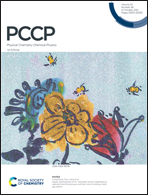Molecular magnetism in nanodomains of isoreticular MIL-88(Fe)-MOFs†
Abstract
Molecular magnetism in nanodomains of three isoreticular MIL-88(Fe) analogues is studied and reported. Microstructures of isoreticular extended frameworks of MIL-88B, MIL-88C, and the interpenetrated analogue of MIL-88D, i.e., MIL-126, with the trigonal prismatic 6-c acs net are synthesized by linking Fe3O inorganic cluster units with organic carboxylate linkers – benzene-1,4-dicarboxylic acid (BDC), 2,6-naphthalene dicarboxylic acid (NDC), and biphenyl-4,4′-dicarboxylic acid (BPDC), using a controlled solvent driven self-assembly process followed by a solvothermal method. The powder XRD traces are matched with the simulated diffraction patterns generated from their corresponding crystal structures, revealing the hexagonal symmetry for MIL-88B and MIL-88C, and the tetragonal symmetry for MIL-126. The elemental composition analysis confirms the empirical formula to be Fe3O(L)3 where L is the organic linker, supporting the formation of isoreticular MIL-88(Fe)-MOFs with MIL-88 topology. The morphologies of microstructures analyzed by SEM and TEM exhibit long spindle shaped rods with a core and a shell-like architecture for MIL-88B and MIL-88 C whereas MIL-126 shows cubic-shaped microstructures. The M–T plots confirm their blocking temperatures, TB, to be 60 K, 50 K, and 40 K for MIL-88B, MIL-88C, and MIL-126, respectively. The M–H plots reveal their magnetic response to be ferromagnetic at 10 K with the coercivities, HC, ranging from 250 G to 180 G. The gradual decrease in the TB and HC correlates with the nanocrystals’ domain size, which decreases from MIL-88B to MIL-88C to MIL-126. Their phase transition from the ferromagnetic state to the short range ordering of the superparamagnetic state is observed in the temperature range of 100 K to 300 K. At T > TB, nanocrystals of all three MIL-88 microstructures act as a single-magnetic domain, owing to their shape anisotropy and finite-dimensionality. The electron density distribution and the spin density state modeled for each MIL-88 analogue exhibit localized electron density and spin density on Fe3O clusters, indicating the short range magnetic moment ordering in triangular metal oxide nodes with no extended magnetic cooperativity from their organic linkers. The short-range ordering of superparamagnetism in MIL-88(Fe)-MOFs suggests their further study as porous molecular-based magnets.

- This article is part of the themed collection: 2021 PCCP HOT Articles


 Please wait while we load your content...
Please wait while we load your content...
